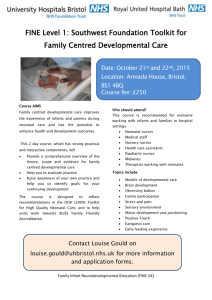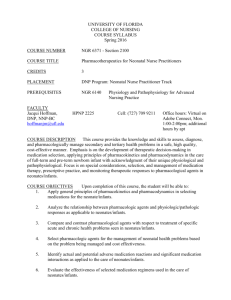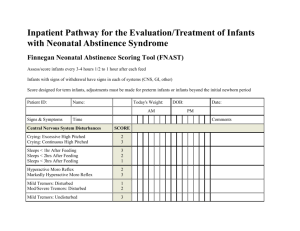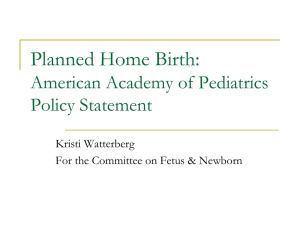ORIENTATION EDUCATION PACKET #8 ~ What a Pain! The
advertisement
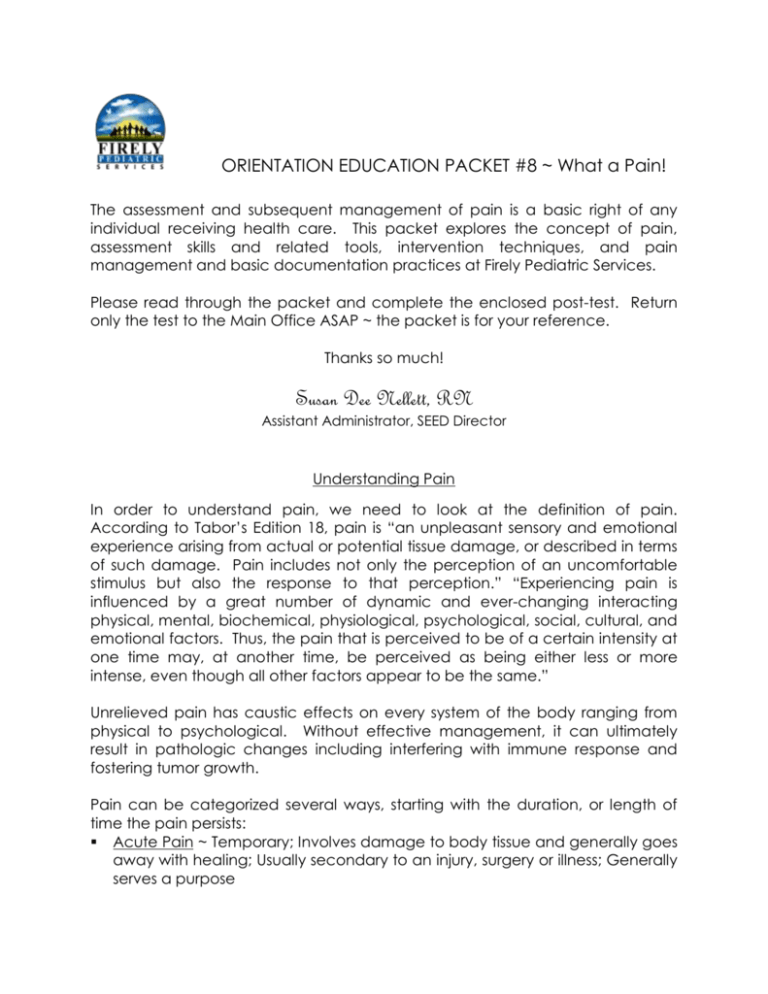
ORIENTATION EDUCATION PACKET #8 ~ What a Pain!
The assessment and subsequent management of pain is a basic right of any
individual receiving health care. This packet explores the concept of pain,
assessment skills and related tools, intervention techniques, and pain
management and basic documentation practices at Firely Pediatric Services.
Please read through the packet and complete the enclosed post-test. Return
only the test to the Main Office ASAP ~ the packet is for your reference.
Thanks so much!
Susan Dee Nellett, RN
Assistant Administrator, SEED Director
Understanding Pain
In order to understand pain, we need to look at the definition of pain.
According to Tabor’s Edition 18, pain is “an unpleasant sensory and emotional
experience arising from actual or potential tissue damage, or described in terms
of such damage. Pain includes not only the perception of an uncomfortable
stimulus but also the response to that perception.” “Experiencing pain is
influenced by a great number of dynamic and ever-changing interacting
physical, mental, biochemical, physiological, psychological, social, cultural, and
emotional factors. Thus, the pain that is perceived to be of a certain intensity at
one time may, at another time, be perceived as being either less or more
intense, even though all other factors appear to be the same.”
Unrelieved pain has caustic effects on every system of the body ranging from
physical to psychological. Without effective management, it can ultimately
result in pathologic changes including interfering with immune response and
fostering tumor growth.
Pain can be categorized several ways, starting with the duration, or length of
time the pain persists:
Acute Pain ~ Temporary; Involves damage to body tissue and generally goes
away with healing; Usually secondary to an injury, surgery or illness; Generally
serves a purpose
Chronic Pain ~ Ongoing or recurrent {such as lower back pain, migraine
headaches, or arthritic conditions}; May have no known cause; Generally
serves no purpose
NOTE: Cancer pain is considered acute {because of tissue damage from
treatment or tumor growth} but it is often of a chronic nature. Therefore,
treatment is extremely varied and not discussed in this packet.
In addition to assessing the duration of pain, categorizing what the pain feels
like is just as important:
Visceral Pain ~ Comes from internal organs; Sensation of burning, cramping,
dull or sharp ache
Somatic Pain ~ Comes from muscles and/or bones; Sensation may be dull,
aching or sharp
Neuropathic Pain ~ Comes from abnormal and/or damaged nerves {i.e.
shingles, diabetes, etc.}; Sensation of burning or deep/sharp aching
Needless to say, different types of pain require different pain management
plans. This must be coordinated through a multi-disciplinary approach utilizing
consistent and accurate assessment skills. The ability to continually assess and
re-assess whether implemented strategies are working is a major key to pain
management.
Besides the actual causes of pain, influential factors can enhance or lessen the
child’s perception of pain. When getting to know a new client, the child and/or
family should be asked about past pain experiences and how the child/family
coped with the episode{s} of pain. It is also very important to identify words the
child uses for pain, as well as his/her reaction to pain and pain management.
Using language a child is familiar with and understands will lead to creating a
more effective pain assessment and management plan.
Areas of Pain Assessment
Unfortunately, there is no standard method of assessing pain in children.
However, pain assessment that incorporates the client’s input, in addition to
influential factors, and physical/behavioral signs and symptoms will result in the
most thorough picture of what the client is enduring.
A variety of pain assessment strategies should be implemented because
different strategies provide qualitative and quantitative information about pain.
Following the acronym “QUESTT” can prove very useful ~
Q ~ Question the Child ~ His/her verbal description of pain is most important!
* Ask the child to locate the pain by pointing to his/her body or a doll
* Speak in the child’s language {i.e. “owie,” “boo-boo,” “hurt,” etc.}
* Be aware that a child may be afraid to verbalize pain because every
time he/she does, they get a “needle”
U ~ Use Pain Rating Scales ~ Provides a subjective, measurable assessment of
pain intensity; See “FPS Pain Management Practices” section of this
packet.
E ~ Evaluate Behavior ~ Physical changes and behavior are both valuable
indicators of pain in children {and non-verbal adults as well}.
*Facial expression is one of the most consistent indicators of pain.
*Observe for physiologic changes in early onset of acute pain {subsides
with continuing or chronic pain}:
Increased pulse, increased BP,
increased respirations, crying, sweating, decreased oxygen saturation,
dilated pupils, flushed or pale skin, nausea, and muscle tension.
*Observe for specific behaviors that traditionally indicate pain: Pulling
ears, rolling from side-to-side, lying on side with legs flexed, limping,
“favoring” or refusing to move a body part, etc.
*Observe for improvement in demeanor indicating a full or partial relief
from pain: Less irritability, cessation of crying, improved sleep patterns,
resumption of usual activities/play.
*Observe for coping strategies; Encourage use during future episodes of
pain: Talking, moaning, lying rigidly still, squeezing a hand, etc.
S ~ Secure Parents/Primary Caregivers’ Involvement ~ After all, they know the
child best!
* A child’s past history related to experiencing pain can be revealed.
* Encouraging parents to use the pain assessment tool involves them in
their child’s care, giving them control and a sense of being able to help.
T ~ Take the Cause of Pain into Account ~ The nature of pathology or
procedures can predict an expected intensity and type of pain.
T ~ Take Action ~ The reason pain is assessed is to be able to provide relief.
Pain Assessment Tools
The sooner a child and family are exposed to assessment tools, the smoother
pain management will proceed. Ideally, the child, family and nursing staff
should be instructed in the use of assessment tools to provide ultimate
consistency. Self-reporting, that is the child relaying exactly what he/she is
feeling, is the best measure of pain. Unfortunately, a child’s age, stage of
development, functional ability, and/or condition may hinder the effectiveness
of self-reporting.
Pain assessment tools that measure pain-related behavior can be used when
self-reporting cannot be obtained or to supplement self-reporting. These tools
are based on behavioral observations and include, but are not limited to the
Neonatal Infant Pain Scale, objective Pain Scale, Nurses Assessment of Pain
Inventory, and FLACC Post-operative Pain Scale {Face, Legs, Activity, Cry, and
ability to be Consoled}. These scales focus on verbalization, vocalization, facial
expression, motor response, and activity. Unfortunately, one drawback is that
research has shown that healthcare providers consistently underestimate a
child’s pain when compared with a child’s self-reporting of his/her own pain.
In addition to behavioral observations, there are many physiological indicators
to be aware of. When a child begins to experience pain, the autonomic
nervous system is activated. As a result, there is a flushing of the skin, sweating,
increased blood pressure/respirations/heart rate, decreased O2 saturations,
increased ETCO2 values, restlessness, and dilation of pupils. One thing to keep in
mind is that if the pain persists, the body begins to adapt, and these
physiological indicators diminish or stabilize. Most importantly, nurses must be
“in-tune” with their assessment skills and ability to find and utilize an effective
pain assessment tool in order to provide accurate pain management.
Changes in Managing Infant Pain
Misconceptions regarding infant pain have hindered strides in managing
neonatal pain though there is progress. Take a look at the following two
scenarios as found in Advance for Nursing, Volume 4, Number 17:
Newborn Nursery 1995 ~ A healthy newborn baby boy is gently lifted out of his
crib. His diaper is removed and he is placed on a cold plastic board and
strapped down. Now much more alert, he looks around as if wondering what is
going on. Soon the circumcision starts and his screams fill the nursery. Everyone
inwardly cringes and wishes there was something they could do to ease his pain.
The physician reassures the nurse saying, “He is only crying because he is
strapped down. Infants do not feel pain because their pain receptors have not
yet fully developed. He won’t remember a thing.”
Newborn Nursery 2002 ~ A healthy newborn baby boy is gently lifted out of his
crib. A pacifier is placed in his mouth, his diaper is removed, and he is placed
on a plastic board lined with a soft blanket and strapped down. He receives a
dose of sucrose followed by the pacifier. His eyes are carefully covered to
protect him from the bright lights. The physician numbs the penis with lidocaine,
chats with the nurse while the lidocaine takes effect, and completes the
circumcision without a cry from the infant. The baby is redressed, swaddled,
and returned to his crib with the pacifier, where he quickly falls asleep.
Having worked in three Newborn Nurseries and two NICU’s, I can vouch that the
2002 scenario is a portrayal of much more effective neonatal pain
management. Improvements in pain management policies have come about
as a result of proving “old myths” wrong. Some such corrected myths are as
follows:
Infants DO feel pain, with as much sensitivity as older infants and children;
Pre-term neonates may have an even greater sensitivity!
Infants CAN express they are in pain ~ Nurses and Mothers have been able to
differentiate between a “hunger” cry, a “pain” cry, and an “I’m bored cry”
for many years!
Infants DO remember pain ~ In the NICU, infants quickly learn that soon after
they smell alcohol or feel a cold, wet sensation on their foot, there will soon
be pain from yet another heelstick.
Infants learn pain from their FIRST incidence ~ They do not have to be stuck
numerous times to know what it means and that it hurts.
Pain CAN be accurately assessed in infants ~ Through close observation and
the use of various tools available, infant pain is able to be accurately
assessed.
Other advances in neonatal pain control have centered around the need for
pain intervention during non-surgical treatment procedures including tracheal
suctioning, spinal taps, mechanical ventilation, and arterial/venous sticks.
Studies done in Finland have shown that neonates undergoing such treatments
suffer hypoxemia despite pre-oxygenation and manual ventilation with
increased inspired O2. As a result, the use of analgesia was found to shorten the
duration of hypoxemia and thereby reduce suffering. In 2009, NICU’s now
routinely make neonatal pain management a priority.
Intervention Techniques for Managing Pain
Non-Pharmacologic Interventions:
Comfort Measures ~ Extremely beneficial in reducing a person’s perception
of their pain. Individualized for each client, they should be routinely
incorporated into the Plan of Care. Some comfort measures include, but are
not limited to repositioning {utilizing age-appropriate devices such as
bumpers, blankets, pillows, etc.}, warm blankets, warm/cool compresses, etc.
Distraction ~ Incorporate activities {i.e. games, puzzles, a walk, TV, video
games, music, reading, etc.}; May also involve family, friends, and/or clergy.
Infant Strategies ~ Pacifier, rocking, swaddling, soothing music, white noise,
stroller ride, car ride, etc.
Relaxation ~ Rocking, limited environmental stimulation {i.e. noise, light,
excessive heat, etc.}, bath time, massage, etc.
Guided Imagery ~ Ask child to identify some highly pleasurable real or
pretend experience such as a visit to Disneyworld; Engage a conversation,
enabling the child to verbalize details of the event, including as many senses
as possible {i.e. feeling drops of water on your face from Splash Mountain,
smelling popcorn, hearing Mickey’s voice and the familiar Disney tunes};
During a painful time, ask the child to concentrate on the image of visiting
Disneyworld; Join in the conversation and talk about the child’s details
regarding the event.
Positive Self-Talk ~ Encourage the child to repeat positive phrases when in
pain {i.e. “I will feel better soon,” “This will be over in just a few minutes,” etc.}.
Cutaneous Stimulation ~ Includes simple, rhythmic rubbing; Use of pressure or
electric vibrator, massage with hand lotion, application of heat/ice to an
area prior to a painful stimuli; Can help to stimulate opposite site {i.e. if left
knee hurts, apply heat/ice to right knee}.
Behavioral Contracting ~ Useful with an older child; Use a written contract
that includes a realistic goal or behavior that is measurable {i.e. not hitting
anyone during a procedure}. Have all persons involved sign the contract.
Always be sure to follow through with identified rewards and/or
consequences in the contract.
Behavioral Interventions ~ Hypnosis, biofeedback desensitization, psychotherapy, play therapy, art therapy, and music therapy.
Neurosurgical Techniques
Neurologic Techniques ~ Transcutaneous electrical nerve stimulation,
acupuncture, etc.
Rehabilitative Techniques ~ PT, OT, exercise program, etc.
Cognitive Interventions ~ Education, demystification, maintaining a diary,
etc.
Spiritual and/or Social Support
Pharmacologic Interventions: All nurses must be aware of pain medications
ordered for their assigned clients. It is very important to understand the intent for
all PRN medication orders {i.e. Which medication should be used for different
types of pain?}. Routes and methods of analgesic medications most widely
used in the home or center include, but are not limited to:
Oral ~ Convenient, lower cost, relatively steady blood levels; Peaks within 1½
to 2 hours; Poor for rapid control of severe pain.
Sublingual/Buccal/Transmucosal ~ More rapid onset than oral meds; Avoids
first-pass effect through liver; Few drugs available in this form.
Bolus Intravenous ~ Preferred for rapid control of severe, acute, procedural,
and/or break-through pain; Needs to be repeated hourly for continuous pain
control; Utilizes drugs with short half-life {morphine, fentanyl, hydromorphone}.
Continuous Intravenous ~ Preferred injection form over bolus and IM for
maintaining control of pain; Provides steady blood levels; Easy to titrate
dosage.
Patient-Controlled Analgesia {PCA} ~ Refers to self-administration, utilizing a
programmable infusion pump that permits self-administration of boluses at
preset dose and time intervals.
Intramuscular ~ Painful administration, hated by most children! Some
medications have the potential to cause tissue damage at the injection site;
Absorption rates fluctuate.
Topical/Transdermal ~ Cream/Gel/Ointment to apply topically; Eliminates or
reduces pain from most procedures involving skin puncture; Also comes in a
“patch” form; Not proven safe for children under age 12.
Rectal ~ Variable absorption rates; Generally disliked by children, but often
preferred over a “needle”!
FPS Pain Management Practices
Home Care: The Case Coordinators assess pain upon admission, during weekly
phone calls with the family/Primary Nurse, and during Home Visits. The nursing
staff MUST make pain assessment a priority during the initial physical assessment
at the start of EVERY SHIFT worked, and follow up with on-going re-assessments
throughout the entire shift. Additionally, pain should be addressed in every
report at the beginning and end of each shift worked.
Building Blocks Program: A child’s pain needs are assessed during the Admission
Process by the admitting nurse. Upon the child’s arrival to the Building Blocks
Program each day, his/her pain is assessed. Appropriate pain management
techniques are to be employed as identified on the Plan of Care {485}. Ongoing re-assessments should occur on a regular basis throughout the child’s day,
ending with a final assessment prior to his/her departure. If the child is
experiencing pain on a regular basis, the attending physician is notified.
Documentation of pain level, measures to relieve pain, and the effectiveness of
medication{s} are documented in the Narrative Notes of the Medical Record.
Home for Kids: A child’s pain needs are assessed during the Admission Process
as well as on an on-going basis. Appropriate pain management techniques
should be employed once identified and detailed in the Plan of Care {485}. If
there is no relief from pain and pain management techniques have been
exhausted, the Child Care Supervisor is notified.
Documentation and
notification of the physician will then be addressed.
Pain tools may be implemented by a child’s physician {or medical facility/clinic}.
If a tool is already in use and is effective, continue using it on a regular basis.
Once a tool is in place and is found to be effective, it should remain in place.
Switching to a new tool can lead to the child’s confusion and should be
avoided. If one is not in place, FPS has a pain assessment tool system for
assessing pain available for use {contact The Building Blocks’ Program Director,
HFK Supervisor, or an FPS Case Coordinator}. The tool is individualized so it is
suitable to the child’s age, abilities, and preference {if able to be expressed}. If
possible, the pain tool should be introduced to the child before pain is
expected. This is ideal in the case of scheduled surgery. The child becomes
familiar with the tool and can put it to good use as soon as it is needed.
Documentation of the Pain Management Process
Pain assessment of children is largely dependent on the age and
developmental capacity of each child. Nonetheless, effective pain relief must
be shown and documented. At a minimum, the following should be included in
your documentation:
Location of pain
Severity of pain through use of a pain assessment tool
Duration of pain
Administration of medication{s} ~ All PRN pain meds MUST have a minimum of
two documentation entries for each administration! The first note is entered
at the time of administration stating what was given and why. Approximately
one hour after administration of any pain med {PRN or routine orders}, enter a
note regarding the effectiveness of the medication as related to the reason it
was given. In other words, How well did the med work on relieving the pain?
This is very important for meeting PA State and Joint Commission
requirements! Consult The Building Blocks’ Program Director, HFK’s Supervisor,
or FPS’s Case Coordinators for further documentation details.
~ Works Cited ~
Loeb, BSN, RN, Jill. (2002 September 16). “Pain Matters.” Advance for Nurses, Greater
Philadelphia, Volume 4, Number 19, 31-33.
McConnell, MD, FAAP, Mark S. (Ed.) (2002). Guidelines for Pediatric Home Health Care.
Sudbury, MA: Jones & Bartlett Publishers.
Oliver, BSN, RN, Julie. (2002 August 19). “Managing Pain in the Youngest.” Advance for
Nurses, Greater Philadelphia, volume 4, Number 17, 33-35.
Thomas, MD, MPH, Clayton L. (Ed.) (1997). Taber’s Cyclopedic Medical Dictionary
(Edition 18). Philadelphia, PA: F.A. Davis Company. 1387-1391.
sdn ~ 09/2004; Rev. 01/2006, 07/2006, 08/2008; 12/2009 LMFM ~ 3/2011
{SEEDS/Orient SEED Packets/Orient #8~What a Pain!}
WHAT A PAIN! EDUCATION PACKET POST-TEST
Name: _____________________________________
_____~_____~_____
True or False ~ Circle the best answer:
TRUE
FALSE
1. Unrelieved pain has no long-lasting effects for a child.
TRUE
FALSE
TRUE
FALSE
TRUE
FALSE
TRUE
FALSE
2. Acute pain is usually due to an injury, surgery, or illness
whereas chronic pain may have no known cause.
3. The same pain management plan will be effective for every
type of pain a child may experience.
4. Pain assessment that includes the child’s input, and physical/
behavioral signs and symptoms will result in more effective pain
management.
5. Infants do not feel nor remember pain.
TRUE
FALSE
6. Pain assessment tools are unreliable and should not be used.
TRUE
FALSE
TRUE
FALSE
TRUE
FALSE
TRUE
FALSE
7. When assessing pain, always take the cause of the pain, if
known, into account.
8. Once a child has been assessed to be in pain, it is important
to take action towards providing relief from that pain.
9. Documentation of pain medication administration must
include a follow-up entry to evaluate the medication’s
effectiveness in relieving the child’s pain.
10. Pain assessment tools are obtained only from the client’s
physician.
Match the types of pain to their specific sources:
_____ 11.
Neuropathic Pain
A. Abnormal or damaged nerves
_____ 12.
Somatic Pain
B. Internal organs
_____ 13.
Visceral Pain
C. Muscles and/or bones
_____ 14. Which of the following is NOT a physiological indicator of pain:
A. Decreased O2 Sats
B. Flushed skin and or sweating
C. Constricted pupils
D. Increased heart rate and/or BP
_____ 15. Which type of injected analgesic drug is preferred for maintaining control of
pain because it provides steady blood levels of the medication?
A. Bolus IV
B. Continuous intravenous
C. Intramuscular
D. Patient-controlled analgesia
sdn ~ 09/2004; Rev. 01/2006, 07/2006, 08/2008; 12/2009; 07/2010 LMFM ~ 3/2011
{Home Care/SEEDS/Orient SEED Packets/Orient #8~What a Pain!}
